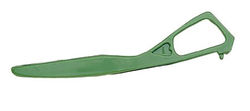Scissor
A scissor is a tool that is used for cutting various materials including paper, fabric and human skin (mainly wrists).
In terms of use, a Scissor is exactly the same as a knife; however the scissor is considerably blunter than a knife. Furthermore, a Scissor can cut things with no effort at all, and therefore doesn't need to be sharp.
This item of stationery is used as the alternative to the popular Scissors, which is basically two Scissors that have been fixed together using the popular hinge material, metal. Some argue that a pair of Scissors would be easier to use and that the Scissor is an outdated instrument. But, the advantage of the Scissor is that it replaced Scissors in the highly popular game, "Rock, Paper, Scissor". New rules also came about because of this; Scissor can beat anything.
History
The Scissor was created by a failing Roman inventor in 99AD. He at first called it a "Single Sciz", however, the idea and the blueprints were stolen by the Roman guards because they suspected that it was a weapon.
It was developed very well, ancient engineers soon built on the original basic idea and constructed the Modern cross-bladed scissors that we know today.
1900 years later, in the year 2000, the Scissor was re-invented after a failing English inventor named Stuart Rose discovered that it was indeed stronger, more usable, less nerdy and much cheaper than a pair of Scissors.
Mechanics
A Scissor is used exactly like a knife; however it is much easier as you need to apply very little pressure.
Despite popular belief, a chainsaw works in exactly the same way. It us not a chain of blades spinning round really fast; it is quite simply a Scissor, with a motor on the back to make noise. The noise is used to warn people that someone has a chainsaw nearby.
Even when cutting large, thick or hard material, the Scissor still comes through when applied to the surface. It is reported that it sometimes makes a mess and that you do not get a clean cut. Many people have complained about the Scissor breaking when they try to carry out that special pumping action.
The applied force of the hand is used to cut things, for example placing two A4 sheets of paper together then pushing and dragging the Scissor along where the two pieces meet will give you two pieces of A4 paper.
Design
The Scissor is basically the same as a knife but with a hole in the handle. This is purely there for convenience, you can use this to hang on the wall, attach to a key ring, for example hanging from the front of your belt so that you can protect yourself from potential attackers during a morning jog, or just for spinning it round really, really fast on your finger.
The hole in the handle and the sheer strength of the blade is the only difference between a knife and a Scissor. However, the fact that a knife sounds more dangerous, doesn't mean it is. The Scissor is disguised as an innocent stationary object, and then.. BAM! you're dead.
Variations on the Scissor
When the English inventor invented the Scissor for the second time, he decided that there were going to be many different versions to appeal to a wider audience.
Safety Scissor
Mainly for children[1]. It has a piece of plastic on the non sharp side[2] to stop them from cutting themselves.
The strips of plastic are normally found in nice, friendly colours, such as red. This will decrease the chance of the children being angered and ending up stabbing the teacher. The invention of the safety Scissor also allowed the Safety Movement of 1999 to remove their rule against running with Scissors, because running with one Scissor is up to 50% safer than running with two.

